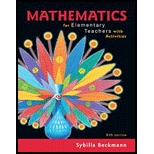
Concept explainers
For each of the following relationships, determine if it is proportional, inversely proportional, or neither. Explain your answer in each case.
a. John and David are running around the same track at the same speed. When David started running, John had already run 3 laps. Consider the relationship between the number of laps that David has run and the number of laps that John has run.
b. Kacey is running 100-meter dashes. Each time she runs at a different, but constant speed. Consider the relationship between the speed at which Kacey runs and the time it takes Kacey to run 100 meters.
c. Maleka is running at a constant speed. Consider the relationship between the time Maleka has spent running and the distance she has run.
d. Water is draining out of a tub at a constant rate. Consider the relationship between the time that has elapsed since water started draining out of the tub and the volume of water remaining in the tub.
e. Water is pouring into a tub at a constant rate. Consider the relationship between the time that has elapsed since water started pouring into the tub and the volume of water in the tub.
Want to see the full answer?
Check out a sample textbook solution
Chapter 7 Solutions
Mathematics for Elementary Teachers with Activities (5th Edition)
Additional Math Textbook Solutions
Pathways To Math Literacy (looseleaf)
Elementary Statistics
Calculus: Early Transcendentals (2nd Edition)
Finite Mathematics for Business, Economics, Life Sciences and Social Sciences
Elementary Statistics: A Step By Step Approach
- Use the method of disks to find the volume of the solid that is obtained when the region under the curve y = over the interval [4,17] is rotated about the x-axis.arrow_forwardsearch P(QP) Q 1.-P:PR 2.-QP:PR 3. Q:MT 1, 2 4. Q:DNE 3 Submit 4.5 P. (QP) Q 1. P: PR 2. Q-P PR 3. -Q:AS 4. -P:MP 2, 3 5. Submit 17 A Previous Chapter Next Chapterarrow_forward1. Find the area of the region enclosed between the curves y = x and y = x. Sketch the region.arrow_forward
- for the given rectangular coordinates, find two sets of polar coordinates for which 0≤θ<2π, one with r>0 and the other with r<0. (-2sqrt(3),9)arrow_forward3) Find the general solution to the following differential equation. d²x = +4x sin² (2t) dt²arrow_forwardI circled the correct answer, could you show me how to do it using divergence and polar coordinatesarrow_forward
- The correct answer is D Could you explain and show the steps pleasearrow_forwardAre the two statements A and B equivalent? (A) p~q (B) ~pq ☐ Statement A and B are equivalent. ☐ Statement A and B are not equivalent as their values in three rows are not identical. ☐ Statement A and B are not equivalent as their values in one row is not identical. ☐ Statement A and B are not equivalent as their values in two row are not identical.arrow_forwardLet p, q and r to be True, False and True statements, respectively. What are the values of the statements below. A: B: [(p→q)^~q]→r (pvq) → ~r O O A: False B: False A: True B: True A: False B: True A: True B: Falsearrow_forward
- Let's assume p and q are true statements. What are the values of the statements below. A: (p→ q) →~p B: (p v~q) → ~(p^q) A: True B: False A: True B: True ☐ A: A: False B: False ☐ A: False B: Truearrow_forwardThree statements A, B and C are given below. Which choice is correct? (A) ~(p^~q) (B) ~p^q (c) pv~q ☐ All statements are inequivalent. ☐ Only statements A and B are equivalent. ☐ Only statements C and B are equivalent. ☐ Only statements A and C are equivalent.arrow_forward6: 000 Which truth table is correct for the given compound statement? (pvq)^p]→q A: B: P P 9 [(pvq)^p]→ 9 T T F T T T T F T T F F F T T F T F F F T F F T C: P 9 [(pvq)^p]→9 D: P 9 [pvq)^p]→9 T T T T T T TF T T F F F T F F T T F F F F F T B A D Previous Page Next Page Page 3 of 11arrow_forward
 Elementary AlgebraAlgebraISBN:9780998625713Author:Lynn Marecek, MaryAnne Anthony-SmithPublisher:OpenStax - Rice University
Elementary AlgebraAlgebraISBN:9780998625713Author:Lynn Marecek, MaryAnne Anthony-SmithPublisher:OpenStax - Rice University Algebra: Structure And Method, Book 1AlgebraISBN:9780395977224Author:Richard G. Brown, Mary P. Dolciani, Robert H. Sorgenfrey, William L. ColePublisher:McDougal Littell
Algebra: Structure And Method, Book 1AlgebraISBN:9780395977224Author:Richard G. Brown, Mary P. Dolciani, Robert H. Sorgenfrey, William L. ColePublisher:McDougal Littell College Algebra (MindTap Course List)AlgebraISBN:9781305652231Author:R. David Gustafson, Jeff HughesPublisher:Cengage Learning
College Algebra (MindTap Course List)AlgebraISBN:9781305652231Author:R. David Gustafson, Jeff HughesPublisher:Cengage Learning College AlgebraAlgebraISBN:9781305115545Author:James Stewart, Lothar Redlin, Saleem WatsonPublisher:Cengage Learning
College AlgebraAlgebraISBN:9781305115545Author:James Stewart, Lothar Redlin, Saleem WatsonPublisher:Cengage Learning
 Intermediate AlgebraAlgebraISBN:9781285195728Author:Jerome E. Kaufmann, Karen L. SchwittersPublisher:Cengage Learning
Intermediate AlgebraAlgebraISBN:9781285195728Author:Jerome E. Kaufmann, Karen L. SchwittersPublisher:Cengage Learning





